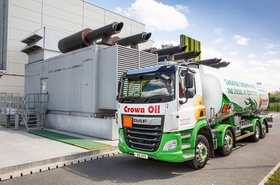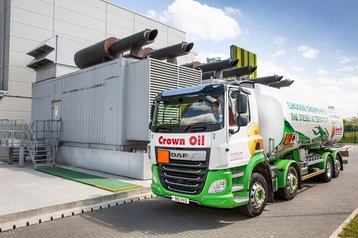Biofuels are as old as the diesel engine: Rudolf Diesel designed his engine for petroleum, but ran his first tests in 1893 using peanut oil.
They are only now coming into their own. To reduce carbon emissions, companies are looking to do away with using fossil fuels such as diesel and swapping back to biofuels that are as readily available as their polluting counterparts and on par in terms of performance.
Hydrotreated vegetable oil (HVO) is a recently-developed low-emission biofuel that promises high performance without the need to replace or customize diesel gen-sets.
Data centers are looking at HVO as a way to green their backup diesel operations. But are the supply chains for this new biofuel ready to keep the world online if there’s a blackout?
What is HVO?
HVO is a synthetic paraffinic diesel, made from vegetable oils or waste, reprocessed with added hydrogen. Unlike previous biofuels, it is a drop-in replacement fuel that can be used without modifications to existing engines.
It offers a similar energy content, density, viscosity, and flash point. Some studies suggest horsepower in HVO-fueled generators may be reduced by 2-3 percent. It also performs very well from start-up in cold climates. It can also be blended with diesel, and can be held for much longer without degrading. Last year Kohler announced that all its mission-critical diesel generators could run on HVO with no modifications. Likewise, Rolls Royce has said its mtu Series 1600 and Series 4000 gensets are also HVO certified.
HVO emits CO2, but most of this was recently captured by plants, so the “net” emissions are much less. Crown Oil reckons 1,000 liters of HVO releases 195kg of net CO2, compared to 3,600kg for the same amount of regular diesel. It also reduces the nitrogen oxide emission by around five percent.
“HVO has a higher stability and lower tendency to oxidize compared to biodiesel, which can lead to fuel degradation over time,” explains Nazmi Atalay, global general manager (Production – R&D) at generator provider AKSA Power Generation. “The stability of HVO is due to the hydrotreating process, which removes impurities and saturates the double bonds in the vegetable oil, resulting in a more stable and uniform fuel.”
Price can be a blocker on adoption; the cost of HVO is currently around 15 percent more than diesel in some markets. But the longer lifespan of HVO – up to 10 years – can offset some of the costs associated with fuel polishing and even scrapping of fuel if microbes gain a foothold in a fuel tank.
“One of the big issues with data centers of course, is that the fuel just sits there forever and a day,” says Simon Lawford, technical sales manager at supplier Crown Oil. “[With HVO] the husbandry of the fuel is a lot simpler and easier. And there's the benefit that you can use it to attract those environmentally conscious clients.”
Lawford notes there’s still confusion with biodiesel, alongside “concern and conservatism” from data center engineers around the performance of HVO. Once companies conduct trials, however, most are happy with the performance.
Who is adopting HVO?
UK operators Kao Data, Ark, and Datum, Compass in the US, as well as Belgium's LCL, and Latvia’s DEAC are all looking to adopt HVO as fuel for their backup generators.
Most haven’t shared exactly how much fuel they are procuring, but Kao said it would be replacing 45,000 liters of diesel, and be procuring more than 750,000 liters when its 35MW Harlow campus is fully developed.
Amazon Web Services (AWS) is also switching to HVO in Europe, beginning with its Irish and Swedish facilities. Digital Realty's French unit has adopted HVO for its new PAR8 site in Paris. The company is also deploying HVO in Madrid, Spain, and plans to expand its use across the continent in the near future.
Stack has previously said it was testing HVO on a generator during the 2021 Texas Ice Storm. It performed well and Stack was deploying HVO at its 8MW TOR01A data center in Toronto, Canada,
Equinix is piloting HVO, but its 2022 environmental, social, and governance (ESG) report doesn’t give details beyond the CO2 savings. Equinix says its HVO generated 30 metric tons of carbon dioxide equivalent (mtCO2e) net, while the equivalent diesel would have generated 40,300 mtCO2e. Using Crown Oil’s 195kg per 1,000 liters benchmark, that comes out at around 150,000 liters of HVO, a fairly significant amount.
Kohler recently swapped diesel for HVO at its Brest generator manufacturing plant in France, totaling some 325,000 liters. Outside of the data center industry, the transportation, construction, aviation, marine, and off-road equipment sectors are all users of HVO.
Crown Oil’s Lawford tells DCD the HS2 rail system uses HVO in the UK, and the Glastonbury music festival has also been using HVO since 2019. It is also approved for use in aviation if upgraded to sustainable aviation fuel (SAF).
Is there enough HVO to go around?
If you want HVO, you can get it, but questions remain around whether an operator would be able to ensure ample ongoing refueling supply during prolonged grid outages.
Production is increasing in tandem with supply, but HVO is still a drop in the ocean compared to other fuels. For example, some 2.26 billion liters of renewable fuel were supplied in the UK in 2022, according to government data. Around seven percent of that is HVO, with biodiesel and bioethanol making up most of the rest.
However, the total amountable of renewable fuel is small compared to overall fuel use. Around 30 billion liters of diesel and 18 billion liters of petrol are consumed in the UK each year in total. Those 2.26 billion liters represent around seven percent of total road and nonroad mobile machinery.
“HVO has been quite a hockey stick,” says Crown Oil’s Lawford. “Back in 2019, there was maybe 5 million liters imported [into the UK] and it's grown pretty exponentially since then, and continues to grow as people switch.”
The feedstock supply is generally good. Some first-generation biofuels are synthesized using oil from purpose-grown produce – palm, sugarcane, soybeans etc. The treated oil in HVO – known as a second-generation biofuel – is usually sourced from the likes of tall oil [a by-product of wood pulp manufacture], rapeseed oil, waste cooking oil, and animal fats.
Existing biodiesels and HVO use largely the same feedstock, meaning the wider raw materials supply chains for the production of HVO are by and large as secure as the wider biodiesel market. B100, a common biofuel, also often uses rapeseed as a feedstock, for example.
Neste is a major producer of HVO and launched its first European refinery in 2007. It has previously told DCD it is actively seeking firms that can supply it with feedstock, including used cooking oil, waste animal fat, and other renewable raw materials. Neste is building a second refinery at Rotterdam. Total, ENI, Cepsa, and Shell are all either producing or building refineries in Europe.
However, some companies DCD spoke to for this article have noted supply chain issues for large orders at short notice.
“There are ongoing supply chain problems with some existing engine suppliers, some companies are in better condition than others in the supply side with well-planned bulk orders,” says AKSA’s Atalay
Adopting HVO with a diesel fallback
Colo giant Digital Realty has hundreds of facilities worldwide and more than 120 in Europe and Africa. The company is starting with HVO in Paris, France, and Madrid, Spain, but intends to roll it out continent-wide in the future.
“We did the tests. I witnessed the tests to make absolutely sure that the fuel would comply with all the security measures and SLAs that we had in place,” says Lex Coors, chief data center technology and engineering officer at Digital Realty. “And I recommended to our VP of operations of EMEA that I am 100 percent behind it and recommend HVO 100 [100 percent HVO] for all countries.
How a company adopts HVO is largely up to them. Crown Oil’s Lawford says the company always recommends a full lift and shift of existing fuel to HVO, but some clients would rather bleed HVO into the system in stages.
“You can mix HVO 100 in any percentage with the existing diesel,” says Coors. “You don’t have to empty your tank. You can simply top it up. In two, three top-ups, I will be at full 100 percent HVO 100."
The fact that HVO can be blended with diesel also means that in an emergency, companies can fall back on diesel in their generators if the HVO supply lines do run dry.
“I think the supply chain is ready for it,” says Lawford. “But the crucial point here is that, unlike biodiesel, you're not wedded to HVO. You can switch straight back; so if the world were to end and there was no HVO available, then you can just use diesel.”
In France, Kohler’s product manager for large diesel generators and clean energies, Pierre Adrien Bel, said the company was able to swap its Brest plant fairly easily in partnership with Total.
“From the first of January we are at 100 percent with HVO100,” he explains. “We did a large cleaning of all our pipes and fuel tanks and then we put HVO 100 inside.”
Can you get HVO in a pinch?
Given enough lead time and willingness to pay, a company can procure almost any amount of HVO. But the fact that the fuel is there as a backup to power generators during potential blackouts means companies need to be sure of steady supply lines at short notice.
“It's always easy to have one or two sites with tanks filled up,” says Digital’s Coors. “The issue is more in the refuel contracts, where you need to have your follow-up fuel within so many hours if you lose the grid.”
Data centers traditionally rely on two fuel suppliers for redundancy during emergencies. The lack of multiple suppliers, combined with a potential shortfall in short-notice fuel deliveries means Digital Realty still has diesel contracts for backup.
“Maybe in two or three years from now there will be multiple HVO 100 suppliers from different factories across Europe, that is the time where we may recommend to our diesel suppliers to go into HVO 100 and stop the fossil fuels,” says Coors.
However, the availability of HVO may depend on location: “Our lead times for HVO [in the UK] are the same as diesel, two working days, or emergency next day,” says Crown’s Lawford, who began with Neste but now has multiple providers. “Crown Oil has nine tanks around the country filled with HVO and it just feeds into our standard lead time in our standard operations.”
Chicken and egg of HVO supply
Europe is currently the largest producer of HVO. Neste has facilities in Rotterdam in the Netherlands and Porvoo in Finland. ENI has HVO production facilities in Venice and Gela and it’s even possible to get HVO at roadside fuel stops in Italy. In France, Total’s La Mède refinery can produce 500,000 tonnes of HVO-type biofuels per year. In Spain, Cepsa recently converted its La Rábida Energy Park in Huelva to produce HVO. Shell is set to build a new refinery in Rotterdam.
US HVO production has grown around 500 percent in the last five to six years, and it's due to double again in the next two years and expected to reach six billion gallons by 2024. In a paper on HVO, Kohler notes Chevron, Phillips 66, Diamond Green Diesel, and Global Clean Energy have all made announcements to increase the capacity of HVO, with a Neste plant in California recently coming online. However, some parts of the country are much further away from production facilities, meaning cost, embedded carbon, and potential logistics issues are greater.
The environmental benefits of adopting HVO may be negated if the fuel has to be transported to a facility thousands of miles away, usually in diesel-fueled trucks.
“For our Brest plant, Total has installed a large local HVO storage so that they are able to supply us at a lower price, next to the facility,” says Kohler’s Bel. But in the US, the company is still working to make the switch: “In California, it will be quite easy to find HVO, whereas, with our plant in Wisconsin, it is more difficult to find. And the cost to transport HVO from California to Wisconsin makes no sense.”
The UK doesn’t produce its own HVO, but can import from Europe and US. The UK last year lifted some EU anti-dumping duties and countervailing measures on HVO imported from the US. The lift means importing HVO from the US is more feasible in the UK than mainland Europe.
Outside of Europe and the US, Neste has an HVO plant in Singapore, but Shell recently scrapped plans for an HVO plant there.
In China, state-owned energy provider Beijing Sanju Environmental Protection & New Materials launched a large refinery in Shandong province in 2021 – its third in total – and plans more, including in Malaysia.
There are no HVO production plants in Africa, South America, Canada, the Middle East, or Australasia – though plants are set to come online in South America and the Middle East in the coming years.
While much more storage infrastructure is dedicated to other biofuels and/or fossil fuel diesel, more HVO customers could see more storage infrastructure reassigned.
Digital Realty says by "taking as much as you can put it in the tanks" production will inevitably increase alongside demand. “If no one is doing this, then the production will not increase. But [higher demand] will increase the production and increase the confidence by those factories to say there is a need, let’s increase production.”
A stepping stone to fuel cells
Kao says one of its MTU 1965kW output diesel generators will consume around 450-500 liters per hour at full load.
Two-hour monthly test runs are standard, resulting in 900- 1,000 liters of mineral diesel producing an average of 3.6 tons of carbon dioxide (CO2) per month. A single diesel generator can create around 43 tons of CO2 per year; the equivalent HVO fuel would produce around 2.3 tons per year (net).
Compared to a Power Purchase Agreement, on-site renewables, or fuel cells, the CapEx of HVO is low - and it makes use of existing generators.
Digital's Coors sees it as merely a temporary stepping stone towards better fuels and then onto fuel cells and hydrogen: “HVO will be definitely a very good solution for the first five to seven years. By 2030 I expect green hydrogen to become more available.“









